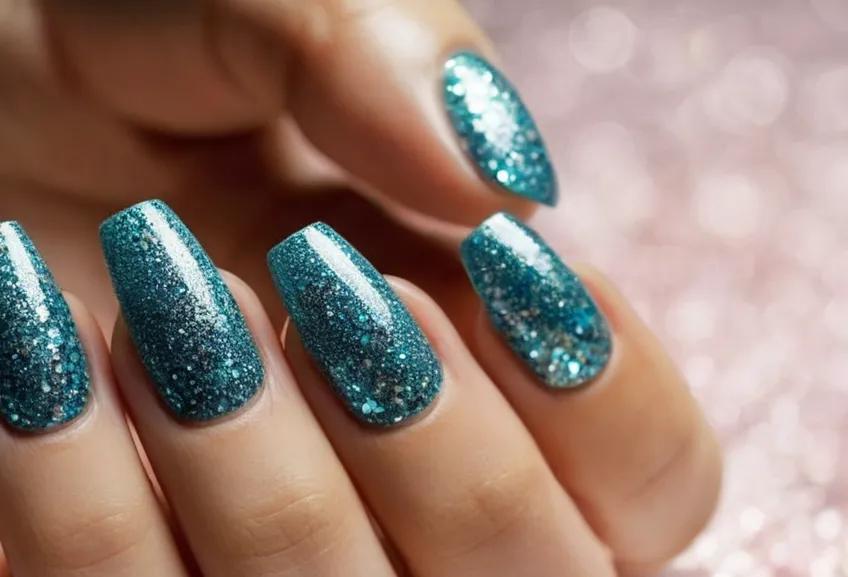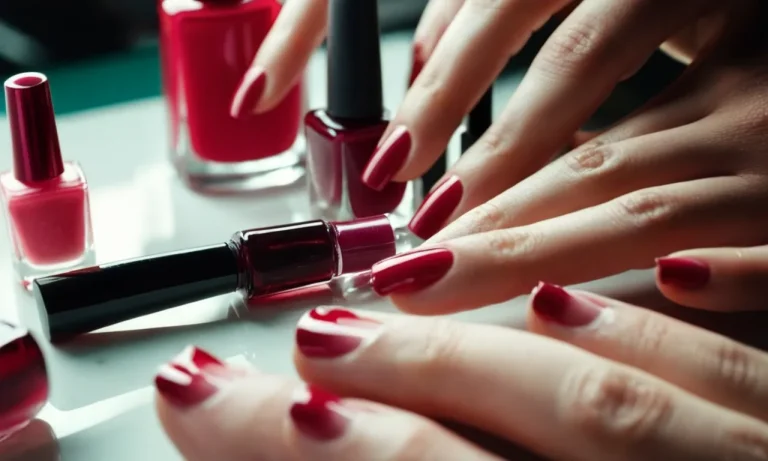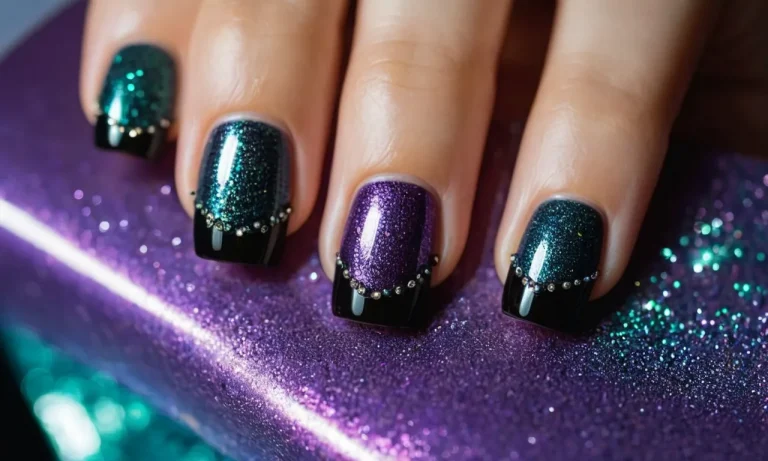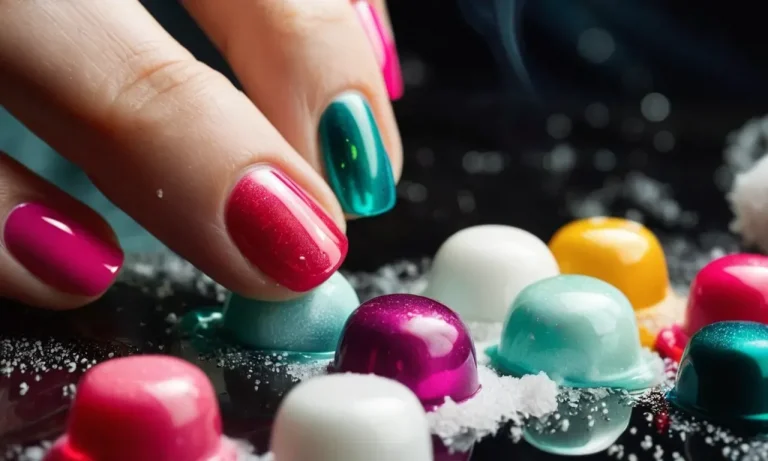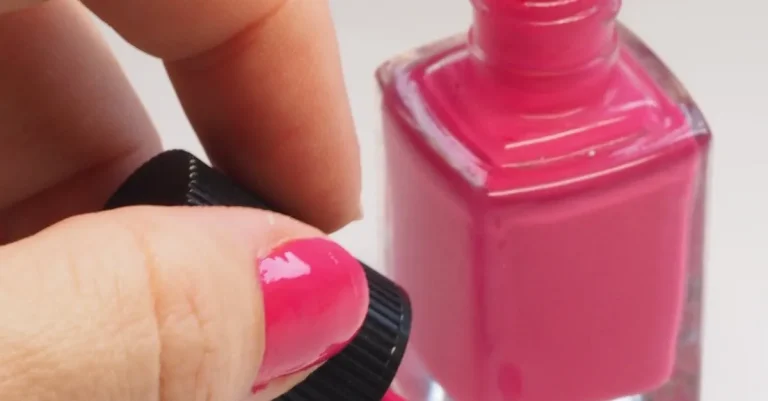Can I Wear Fake Nails With Onycholysis?
If you have onycholysis, or nail lifting, you may be wondering if you can still wear fake nails. Onycholysis causes the nail to separate from the nail bed, resulting in white patches or strips on the nails that can look unsightly.
While fake nails can help cover up the appearance of onycholysis, they need to be applied carefully to avoid exacerbating the condition. In this comprehensive guide, we’ll cover everything you need to know about wearing fake nails with onycholysis.
The quick answer is yes, you can wear fake nails with onycholysis, but they should be applied by a skilled nail technician who understands how to avoid lifting the natural nail further and causing additional damage.
What Is Onycholysis?
Onycholysis, also known as a detached nail, refers to the separation of the nail plate from the nail bed. The condition causes the nail to lift away from the skin underneath, creating a pocket where bacteria, fungi, and other pathogens can enter and cause infection.
Onycholysis has several potential causes and varying symptoms depending on severity.
Definition and Causes
Onycholysis occurs when the seal between the nail plate and nail bed weakens, allowing air and moisture underneath the nail. This detachment creates an entry point for substances that can discolor and infect the nail. Common causes leading to onycholysis include:
- Injury or trauma to the nail
- Allergic reactions to nail enhancements or products
- Skin conditions like psoriasis and eczema
- Fungal infections
- Repeated exposure to water and chemicals
- Medications and medical treatments like chemotherapy
While anyone can develop a detached nail, factors like genetics, circulation issues, and weakened immune systems may increase susceptibility. Fingernails detach more frequently than toenails.
Symptoms and Appearance
In mild cases, the detached area of an onycholytic nail may resemble a white, yellowish, or brown-colored spot. As separation increases, the pocket beneath the nail becomes more visible. An odor might occur if bacteria or fungi enter the space underneath. Other potential symptoms include:
- Nail plate appearing lifted or rippled
- Debris accumulating under the nail
- Pain if the nail bed gets inflamed or infected
- Changes in nail thickness or brittleness
- Discolored streaks on the nail plate
| Mild Onycholysis | Severe Onycholysis |
| Small white/yellow area of nail separation, most commonly occurring on hands | Significant lifting and detachment of the nail plate, typically affecting toenails |
As per statistics from the American Academy of Dermatology (AAD), around 2-3% of adults suffer from onycholysis. The condition more commonly arises in women and people over age 40.
Risks and Complications
While an isolated detached nail may not cause discomfort, leaving the condition untreated heightens the risk of secondary infections and other nail disorders like:
- Paronychia – inflammation of nail fold
- Candidiasis – fungal infection
- Bacterial infection of nail bed
- Permanent nail deformity or thickening
- Chronic onychomycosis
As the nail continues detaching, pain can occur when pressure is applied to the nail bed. Individuals with uncontrolled diabetes or autoimmune conditions face increased dangers of developing secondary infections and other complications.
Visit reputable medical websites like the Mayo Clinic and American Academy of Dermatology for more information on prevention and treatment of onycholysis: https://www.mayoclinic.org/diseases-conditions/nail-fungus/symptoms-causes/syc-20353294, https://www.aad.org/public/diseases/a-z/detached-nails-onycholysis
Can Fake Nails Be Worn with Onycholysis?
Benefits of fake nails for onycholysis
Applying fake nails can provide some benefits for those with onycholysis. The artificial nails help protect the damaged nail bed from trauma while allowing the natural nail to grow out and recover. They also cover up the unsightly appearance of the separated nail, which can improve self-esteem.
Some key advantages of fake nails include:
- Providing a smooth, even surface over the uneven natural nail
- Protecting the fragile nail bed from bumps and scrapes
- Allowing the natural nail to grow out while camouflaged
- Improving the aesthetic look of the hands
- Boosting confidence in the appearance of the nails
Potential risks and how to mitigate them
However, fake nails also carry some potential risks, especially if improperly applied. To safely wear fake nails with onycholysis:
- Choose reputable salons and properly trained/licensed technicians to apply the nails
- Select shorter nail lengths to avoid leverage and trauma on the natural nails
- Use light-cured gel or acrylic formulations for longer wear and strength
- Avoid using glue-on nails as these are more likely to lift and separate
- Gently file off old polish rather than vigorously scraping the nail plate
- Moisturize and gently push back cuticles rather than cutting them
- Limit direct water exposure by wearing gloves for chores
- Use a nail strengthener or hardener under fake nails
Following professional recommendations and not over-manipulating the nails can help reduce risks like infection, reaction, or further nail plate separation.
Tips for safe application
To safely apply fake nails over onycholytic nails:
- Prep nails by gently filing and removing old polish – do not pick or peel
- Apply nail dehydrator and pH-balanced primer
- Gently push back cuticles but do not cut them
- Use a nail tip sizer to properly fit the nail tips
- Lightly rough up underside of tips and inside of natural nail for bonding
- Brush thin layers of gel or acrylic over the entire nail and extension
- Use thin coats and cure each layer fully to avoid excess product or heat
- Shape and buff to desired finish, avoiding filing the natural nail plate
Properly prepping the nail bed and using thin, precise application techniques can help create a long-lasting manicure that protects the underlying nail.
Caring for Nails with Onycholysis
Keeping nails clean and dry
One of the most important things you can do when caring for nails with onycholysis is to keep them clean and dry. Here are some tips:
- Wash your hands frequently with mild soap and water. Rinse thoroughly and gently pat dry with a clean towel.
- Avoid prolonged exposure to water when bathing, doing dishes, etc. Wear gloves for extra protection.
- Thoroughly dry the nail plate and surrounding skin after washing. You may want to use a blow dryer on a low setting.
- Avoid using nail polish or artificial nails, as these can trap moisture against the nail.
Keeping the area clean and dry prevents dirt, debris and moisture from worsening the separation between the nail plate and nail bed. This helps minimize the risk of infection.
Using nail hardeners and conditioners
Nail hardeners and conditioners can be helpful for strengthening soft, peelining nails affected by onycholysis. Here’s how to use them properly:
- Look for products containing ingredients like calcium, formaldehyde, silk protein or hydroxymethyl-methacrylate (HMMM). These help harden and reinforce weak nails.
- Apply a thin layer onto the nail plate daily or as directed. Avoid getting these products on the surrounding skin.
- Be patient. It takes time for damaged nails to grow out and improve with continued use of strengthening products.
- Use a nail file to shape nails and thin out overly thickened areas if needed.
- Remove enhancement products and give nails a break every few weeks.
Strengthening nail products promote growth of healthy new nails. They may also help adhere the separated nail plate to the nail bed as it grows out. However, nails remain fragile until fully grown out.
Avoiding further damage and trauma
Preventing additional injury to nails with onycholysis is key. Follow these tips to avoid worsening the separation:
- Trim nails to a shorter length to reduce risk of catching and tearing.
- Wear gloves for household chores and gardening to protect nails.
- Pad fingers when playing sports to avoid direct blows.
- Use care when filing nails to avoid tearing of the lifted edges.
- Don’t pick at separated edges or dig under nails, as this can pull the nail plate away further.
- Avoid artificial nails or nail extensions that require glue or damage the nail plate.
Shielding nails from additional trauma allows the underlying issue causing onycholysis to resolve without aggravating the problem. Protective measures also reduce the chance of introducing bacteria under the nail that could lead to infection.
When to See a Doctor
If the condition worsens or spreads
Seeing a dermatologist is advised if the separation and lifting of the nail from the nail bed (onycholysis) worsens or spreads to multiple nails. The dermatologist can properly diagnose the cause and severity of the condition.
Leaving onycholysis untreated may allow it to progressively get worse, increasing the risk of nail infections or permanent nail deformities. Consulting a dermatologist quickly when any changes occur can help prevent complications and permanent damage.
For treatment beyond cosmetic care
While some cases of onycholysis may be managed at home with cosmetic techniques like nail polish or acrylics to disguise the appearance, seeing a dermatologist is recommended for medical treatment. A dermatologist can prescribe topical medications, oral medications, or other therapies to treat the underlying cause of the separated nail.
This helps address not just the cosmetic issues but the root cause of the problem for improved nail health.
To check for underlying causes
Consulting with a dermatologist when onycholysis occurs can help diagnose any underlying medical conditions that may be contributing to the nail separation. Onycholysis may result from issues like trauma, frequent wetting and drying of nails, excessive manicures, infections, autoimmune diseases, drugs, or medical conditions like diabetes, psoriasis, and thyroid disease.
A dermatologist can perform tests and a full health evaluation to pinpoint any underlying factors and then provide appropriate care or referrals to other specialists if needed.
According to research published in the International Journal of Trichology, seeing a dermatologist promptly when onycholysis appears can help improve outcomes and avoid complications like secondary infections under the nail plate. Early diagnosis and management are key.
The American Academy of Dermatology recommends seeing a dermatologist for any nail concerns that do not resolve on their own within a few weeks, are very painful, cause issues with daily living, or are accompanied by other symptoms. This helps ensure proper diagnosis and treatment.
Conclusion
Onycholysis can be frustrating to deal with, but fake nails applied properly can help disguise the appearance of lifted nails. Work with an experienced nail tech to find a safe fake nail option. Keep nails clean and moisturized, and see a dermatologist if the condition persists or worsens.
With some care and caution, you can safely wear fake nails even with onycholysis.
In summary, fake nails are generally okay for people with onycholysis as long as care is taken not to cause further lifting. Consult a nail technician experienced with onycholysis for proper application and removal. Maintain good nail hygiene and moisturization, and see a doctor if problems develop.

